Analysis and Application of Drought Characteristics Based on Theory of Runs and Copulas in Yunnan, Southwest China
Abstract
1. Introduction
2. Study Area and Data
3. Methodology
3.1. Drought Index
3.2. Drought Event Identification
3.3. Marginal Distribution of Characteristic Variables
3.4. The Joint Distribution Model Based on Two-Dimensional Copulas
3.5. Return Period of Drought
4. Results
4.1. Spatial Distribution Characteristics of Drought Frequency
4.2. Drought Event Identification
4.3. Determination of Copula
4.3.1. Determination of the Marginal Distribution of Drought Characteristic Variables
4.3.2. Determination of the Joint Distribution Function of the Drought Characteristic Variables
4.4. Joint Probability
4.5. Joint Return Period
4.6. Application of Joint Return Period in Agrometeorological Disasters
5. Discussion
6. Conclusions
Author Contributions
Funding
Acknowledgments
Conflicts of Interest
References
- Allen, S.K.; Plattner, G.K.; Nauels, A.; Xia, Y.; Stocker, T.F. Climate Change 2013: The Physical Science Basis. An Overview of the Working Group 1 Contribution to the Fifth Assessment Report of the Intergovernmental Panel on Climate Change (IPCC); Cambridge University Press: Cambridge, UK; New York, NY, USA, 2013; pp. 143–151. [Google Scholar]
- Mishra, A.K.; Singh, V.P. A review of drought concepts. J. Hydrol. 2010, 391, 202–216. [Google Scholar] [CrossRef]
- Kim, H.; Park, J.; Yoo, J.; Kim, T. Assessment of drought hazard, vulnerability, and risk: A case study for administrative districts in South Korea. J. Hydro-Environ. Res. 2015, 9, 28–35. [Google Scholar] [CrossRef]
- Park, S.; Im, J.; Jang, E.; Rhee, J. Drought assessment and monitoring through blending of multi-sensor indices using machine learning approaches for different climate regions. Agric. Forest. Meteorol. 2016, 216, 157–169. [Google Scholar] [CrossRef]
- Kwon, H.; Lall, U. A copula-based nonstationary frequency analysis for the 2012–2015 drought in California. Water Resour. Res. 2016, 52, 5662–5675. [Google Scholar] [CrossRef]
- Ayantobo, O.O.; Li, Y.; Song, S.; Javed, T.; Yao, N. Probabilistic modelling of drought events in China via 2-dimensional joint copula. J. Hydrol. 2018, 559, 373–391. [Google Scholar] [CrossRef]
- Wang, X.; Zhang, Y.; Feng, X.; Feng, Y.; Xue, Y.; Pan, N. Analysis and application of drought characteristics based on Theory of Runs and Copula function. Transa. Chin. Soc. Agric. Eng. 2017, 33, 206–214. [Google Scholar]
- Ma, J.; He, P.; Peng, G.; Gui, B.; Liu, L. Analyzing the drought frequency in Shaying river basin using the three-dimensional copula function. J. Irrig. Drain. 2017, 36, 102–107. [Google Scholar]
- Xu, K.; Yang, D.; Xu, X.; Lei, H. Copula based drought frequency analysis considering the spatio-temporal variability in southwest China. J. Hydrol. 2015, 527, 630–640. [Google Scholar] [CrossRef]
- Zhou, Y.; Liu, L.; Zhou, P.; Jin, J.; Li, J.; Wu, C. Identification of drought and frequency analysis of drought characteristics based on palmer drought severity index model. Trans. Chin. Soc. Agric. Eng. 2014, 30, 174–184. [Google Scholar]
- Zhang, D.; Yan, D.; Lu, F.; Wang, Y.; Feng, J. Copula-based risk assessment of drought in Yunnan province, China. Nat. Hazards 2015, 75, 2199–2220. [Google Scholar] [CrossRef]
- Wang, L.; Wang, S.; Wang, X.; Zhang, L.; Wang, F. Feasibility study of five drought indices for use in Yunnan Province. J. Irrig. Drain. 2017, 36, 117–124. [Google Scholar]
- Liu, X.; Wang, S.; Zhou, Y.; Wang, F.; Yang, G.; Liu, W. Spatial analysis of meteorological drought return periods in China using Copulas. Nat. Hazards 2016, 80, 367–388. [Google Scholar] [CrossRef]
- Hesami Afshar, M.; Sorman, A.; Yilmaz, M. Conditional Copula-based spatial–temporal drought characteristics analysis-A case study over turkey. Water 2016, 8, 426. [Google Scholar] [CrossRef]
- Herbst, P.H.; Bredenkamp, D.B.; Barker, H.M.G. A technique for the evaluation of drought from rainfall data. J. Hydrol. 1966, 4, 264–272. [Google Scholar] [CrossRef]
- Lu, J.; Yan, J.; Li, Y. The temporal variation characteristics of drought in Yunnan-Guizhou area during 1960 to 2014 based on SPEI and run-length theory. J. Zhejiang Univ. (Sci. Edit.) 2018, 45, 363–372. [Google Scholar]
- Zuo, D.; Hou, W.; Yan, P.; Feng, T. Research on drought in southwest China based on the theory of run and two-dimensional joint distribution theory. Acta Phys. Sin. 2014, 63, 53–64. [Google Scholar]
- Sklar, M. Fonctions de Repartition à n Dimensions et Leurs Marges, 1st ed.; Publication de l’Institut de Statistique de l’Université de Paris: Paris, France, 1960; pp. 229–231.
- Shiau, J.T.; Modarres, R. Copula-based drought severity-duration-frequency analysis in Iran. Meteorol. Appl. 2009, 16, 481–489. [Google Scholar] [CrossRef]
- Serinaldi, F.; Kilsby, C.G. A blueprint for full collective flood risk estimation: Demonstration for european river flooding. Risk Anal. 2017, 37, 1958–1976. [Google Scholar] [CrossRef]
- Tosunoglu, F.; Kisi, O. Joint modelling of annual maximum drought severity and corresponding duration. J. Hydrol. 2016, 543, 406–422. [Google Scholar] [CrossRef]
- Kwon, H.; Lall, U.; Kim, S. The unusual 2013–2015 drought in South Korea in the context of a multicentury precipitation record: Inferences from a nonstationary, multivariate, Bayesian copula model. Geophys. Res. Lett. 2016, 43, 8534–8544. [Google Scholar] [CrossRef]
- Zhang, L.; Wang, H.; Tong, J. Research on the construction of emergency management pattern for extreme droughts in Yunnan. China Pop. Resour. Environ. 2014, 24, 161–168. [Google Scholar]
- Tao, Y.; Zhang, W.; Duan, C.; Chen, Y. Climatic causes of continuous drought over Yunnan Province from 2009 to 2012. J. Yunnan Univ. 2014, 36, 866–874. [Google Scholar]
- Yu, W.; Shao, M.; Ren, M.; Zhou, H.; Jiang, Z.; Li, D. Analysis on spatial and temporal characteristics drought of Yunnan Province. Acta Ecol. Sin. 2013, 33, 317–324. [Google Scholar] [CrossRef]
- Zhang, D.; Lu, F.; Yan, D.; Wang, Y.; Zhao, J. Spatio-temporal analysis of droughts and the characteristic of continuous seasonal droughts probability in Yunnan Province. J. Basic Sci. Eng. 2014, 22, 705–717. [Google Scholar]
- Jin, Y.; Kuang, X.; Yan, H.; Wan, Y.; Wang, P. Studies on Distribution Characteristics and Variation Trend of the Regional Drought Events over Yunnan in Recent 55 Years. Meteorol. Mon. 2018, 44, 1169–1178. [Google Scholar]
- Cao, Y.; Wang, J.; Li, Y.; Wang, S.; Qi, N. The Spatial and Temporal Characteristics of Drought During Summer Maize at Different Growth Stages in Yunnan Province Based on Crop Water Deficit Index. J. Irrig. Drain. 2019, 38, 98–106. [Google Scholar]
- Wu, W.; Li, Y.; Xiao, L.; Zhang, Y.; Ji, X.; Li, X. Performance evaluation of the CHIRPS precipitation dataset and its utility in drought monitoring over Yunnan Province, China. Geomat. Nat. Haz. Risk 2019, 10, 2145–2162. [Google Scholar] [CrossRef]
- Department of Water Resources of Yunnan Province. 2010 Bulletin of Water Resources in Yunnan Province; Department of Water Resources of Yunnan Province: Kunming, China. Available online: http://www.wcb.yn.gov.cn/ (accessed on 23 March 2019).
- Long, D.; Shen, Y.; Sun, A.; Hong, Y.; Longuevergne, L.; Yang, Y.T.; Li, B.; Chen, L. Drought and flood monitoring for a large karst plateau in Southwest China using extended GRACE data. Remote Sens. Environ. 2014, 155, 145–160. [Google Scholar] [CrossRef]
- Zhang, Q.; Zou, X.; Xiao, F. Classification of Meteorological Drought; Standards Press of China: Beijing, China, 2006. [Google Scholar]
- Yevjevich, V.; Ingenieur, J.; Inge’nieur, Y.; Engineer, Y. An Objective Approach to Definition and Investigations of Continental Hydrologic Droughts; Colorado State University: Fort Collins, CO, USA, 1967. [Google Scholar]
- Lu, G.; Yan, G.; Wu, Z.; Kang, Y. Regional drought analysis approach based on copula function. Dvancesin Water Sci. 2010, 21, 188–193. [Google Scholar]
- Li, T.; Wang, S.; Zhuang, W.; Liu, T. Application of the theory of run and Copula function to the joint distribution of two-dimension drought variables. J. Arid Land Resour. Environ. 2016, 30, 77–82. [Google Scholar]
- Zuo, D.; Hou, W.; Hu, J. An entropy-based investigation into bivariate drought analysis in China. Water 2017, 9, 632. [Google Scholar] [CrossRef]
- Wen, K.; Liu, J. China Meteorological Disaster (Yunnan Volume), 1st ed.; China Meteorol. Press: Beijing, China, 2006; pp. 16–47.
- Zhou, Y.; Yuan, X.; Jin, J.; Li, J.; Song, S. Regional hydrological drought frequency based on Copulas. Sci. Geogr. Sin. 2011, 31, 1383–1388. [Google Scholar]
- Song, S.; Cai, H.; Jin, J.; Tang, Y. Copulas Function and Its Application in Hydrology, 1st ed.; Sci. Press: Beijing, China, 2012; pp. 1–388. [Google Scholar]
- Li, Y.; Gu, W.; Cui, W.; Chang, Z.; Xu, Y. Exploration of copula function use in crop meteorological drought risk analysis: A case study of winter wheat in Beijing, China. Nat. Hazards 2015, 77, 1289–1303. [Google Scholar] [CrossRef]
- Hangshing, L.; Dabral, P. Multivariate Frequency Analysis of Meteorological Drought Using Copula. Water Resour. Manag. 2018, 32, 1741–1758. [Google Scholar] [CrossRef]
- Chang, J.; Li, Y.; Wang, Y.; Yuan, M. Copula-based drought risk assessment combined with an integrated index in the Wei River Basin, China. J. Hydrol. 2016, 540, 824–834. [Google Scholar] [CrossRef]
- Maeng, S.; Azam, M.; Kim, H.; Hwang, J. Analysis of Changes in Spatio-Temporal Patterns of Drought across South Korea. Water 2017, 9, 679. [Google Scholar] [CrossRef]
- Vo, Q.; So, J.; Bae, D. An Integrated Framework for Extreme Drought Assessments Using the Natural Drought Index, Copula and Gi* Statistic. Water Resour. Manag. 2020, 34, 1353–1368. [Google Scholar] [CrossRef]
- Shiau, J.T. Fitting drought duration and severity with two-dimensional Copulas. Water Resour. Manag. 2006, 20, 795–815. [Google Scholar] [CrossRef]
- Shiau, J.T.; Shen, H.W. Recurrence analysis of hydrologic droughts of differing severity. J. Water Resour. Plann. Manag. 2001, 127, 30–40. [Google Scholar] [CrossRef]
- Shiau, J.T. Return period of bivariate distributed extreme hydrological events. Stoch. Env. Res. Risk. 2003, 17, 42–57. [Google Scholar] [CrossRef]
- Zhang, Y.; Jiang, S.; Jin, J.; Wu, Z.; Zhou, Y.L. Computational methods of drought return periods based on the regional agricultural water consumption. Adv. Water Sci. 2017, 28, 691–701. [Google Scholar]
- Chang, W.; Liang, Z.; Li, Y.; Duan, Q. Drought partition and agricultural drought risk zoning in Yunnan Province. J. Irrig. Drain. 2017, 36, 44–51. [Google Scholar]
- Zhang, L.; Wang, Y.; Chen, Y.; Bai, Y.; Zhang, Q. Drought Risk Assessment in Central Asia Using a Probabilistic Copula Function Approach. Water 2020, 12, 421. [Google Scholar] [CrossRef]
- Pontes, J.D.P.; Souza, F.D.S.; Martins, E.S.P.R.; Studart, T.M.D. Copula-Based Multivariate Frequency Analysis of the 2012–2018 Drought in Northeast Brazil. Water 2020, 12, 834. [Google Scholar] [CrossRef]
- Amirataee, B.; Montaseri, M.; Rezaie, H. Regional analysis and derivation of copula-based drought Severity-Area-Frequency curve in Lake Urmia basin, Iran. J. Environ. Manag. 2018, 206, 134–144. [Google Scholar] [CrossRef] [PubMed]
- Li, M.; Hu, W.; Wang, G.; Chai, X.; Zhang, L. Drought Risk in Monsoon Area of the Eastern China Based on Copula Function. Sci. Geogr. Sinica. 2019, 39, 506–515. [Google Scholar]
- Hou, C.; Zhu, X.; Xiao, M.; Xiao, G.; Chen, C. Research on Agricultural Meteorological Drought in Liaoning Province based on Run Theory and Copula Function. J. Catastrophol. 2019, 34, 222–227. [Google Scholar]
- Yao, R.; Sun, P.; Zhang, Q. Hydrological drought frequency based on Copulas in Huai River Basin. J. Beijing Norm. Univ. (Nat. Sci.) 2019, 55, 755–763. [Google Scholar]
- Chen, J.; Gu, S.; He, D.; Gang, C. Return period of drought In Dianchi Basin In last 60 years. Resour. Environ. Yangtze Basin 2016, 25, 1457–1465. [Google Scholar]
- Li, Q.; Wang, Y.; Xu, Y.; Yu, H.; Long, S.; Huang, J. Hazard assessment of drought disasters in Beijing-Tianjin-Hebei region based on Copula for recent 60 years. Arid Land Geogr. 2019, 42, 1310–1321. [Google Scholar]
- Fenech, J.P.; Vosgha, H.; Shafik, S. Loan default correlation using an Archimedean copula approach: A case for recalibration. Econ. Model. 2015, 47, 340–354. [Google Scholar] [CrossRef]
- Xu, X.; Xu, K.; Yang, D.; Li, J. Drought identification and drought frequency analysis based on multiple variables. Adv. Water Sci. 2019, 30, 373–381. [Google Scholar]
- Hui-Mean, F.; Yusof, F.; Yusop, Z.; Suhaila, J. Trivariate copula in drought analysis: A case study in peninsular Malaysia. Theor. Appl. Climatol. 2019, 138, 657–671. [Google Scholar] [CrossRef]
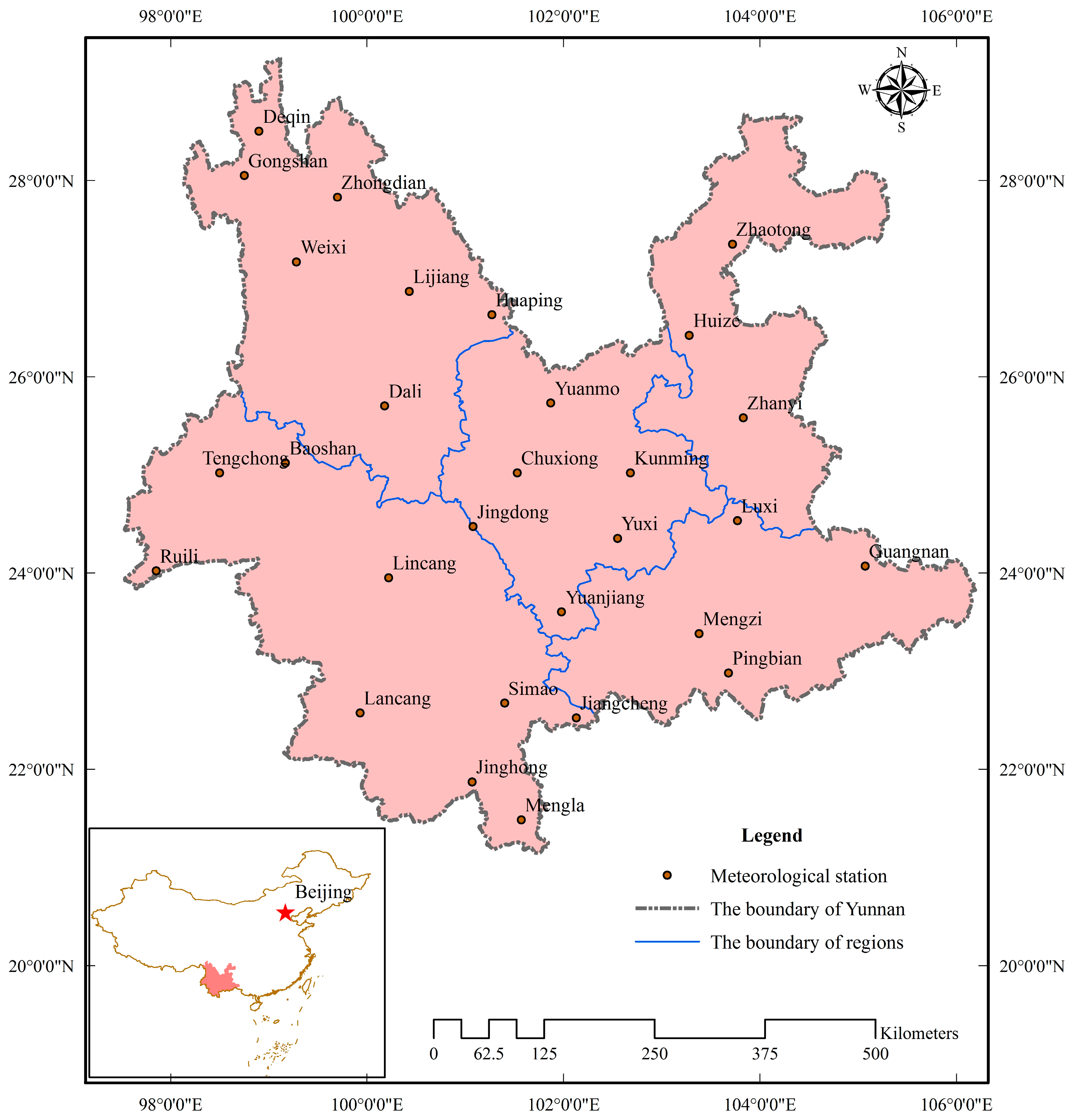
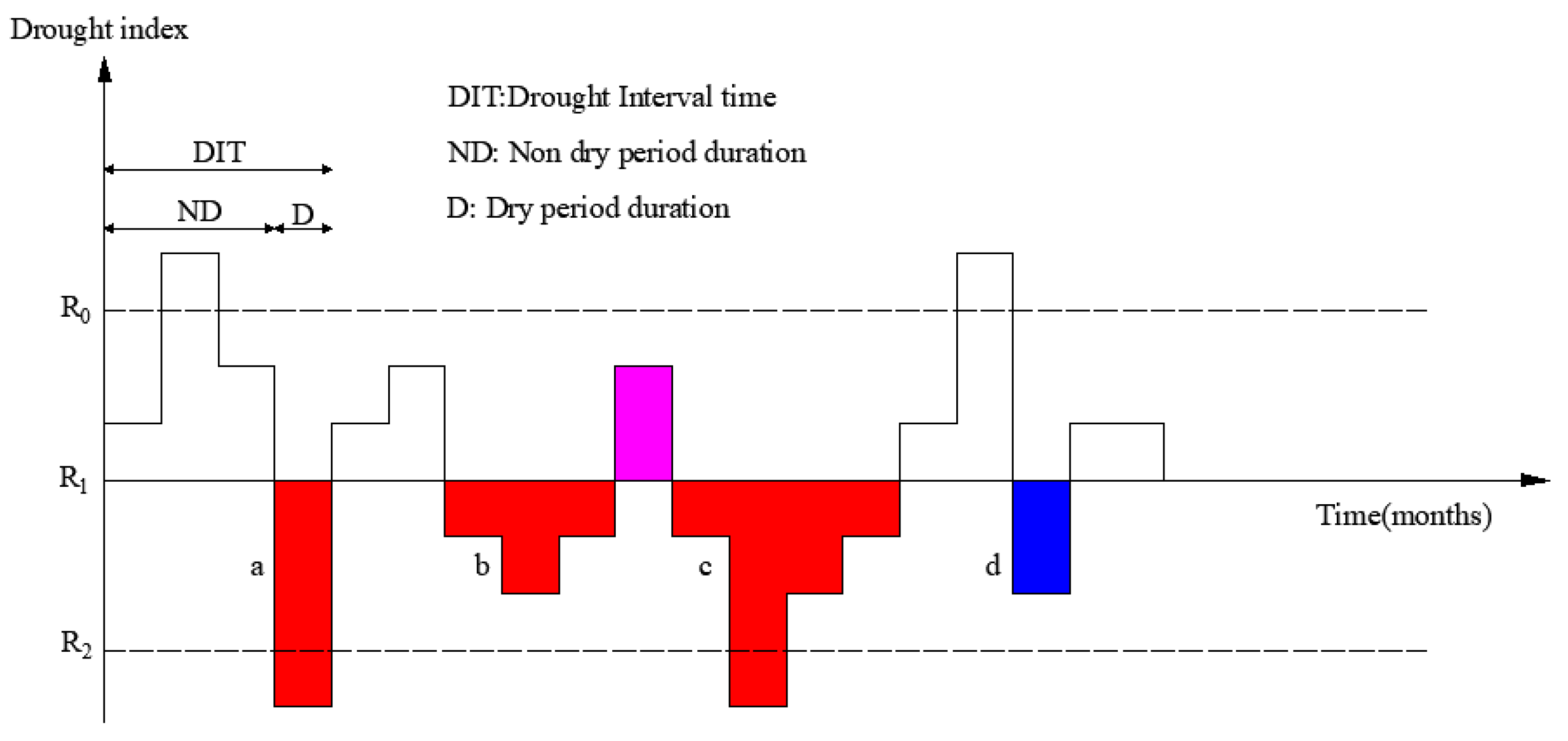
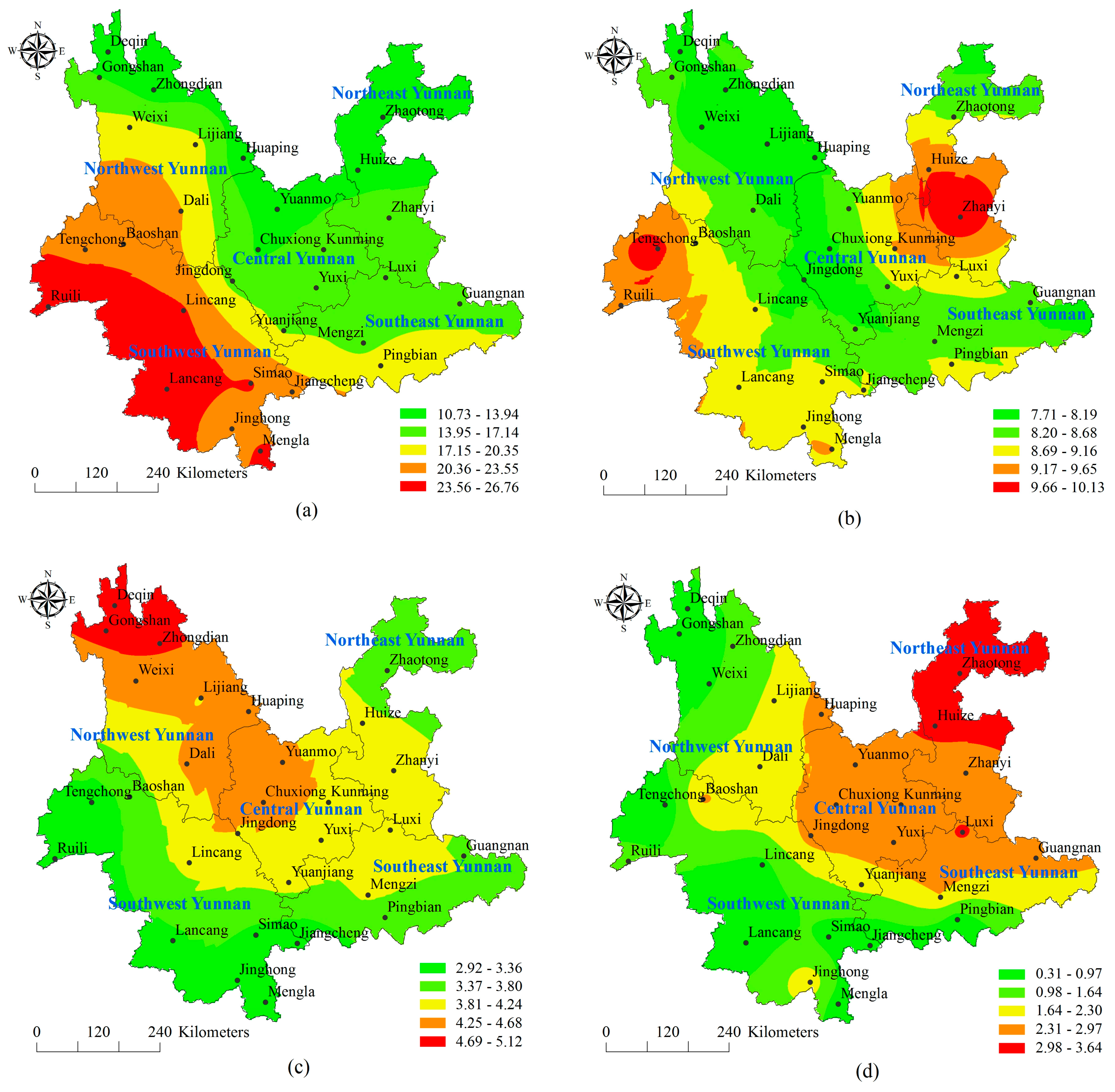
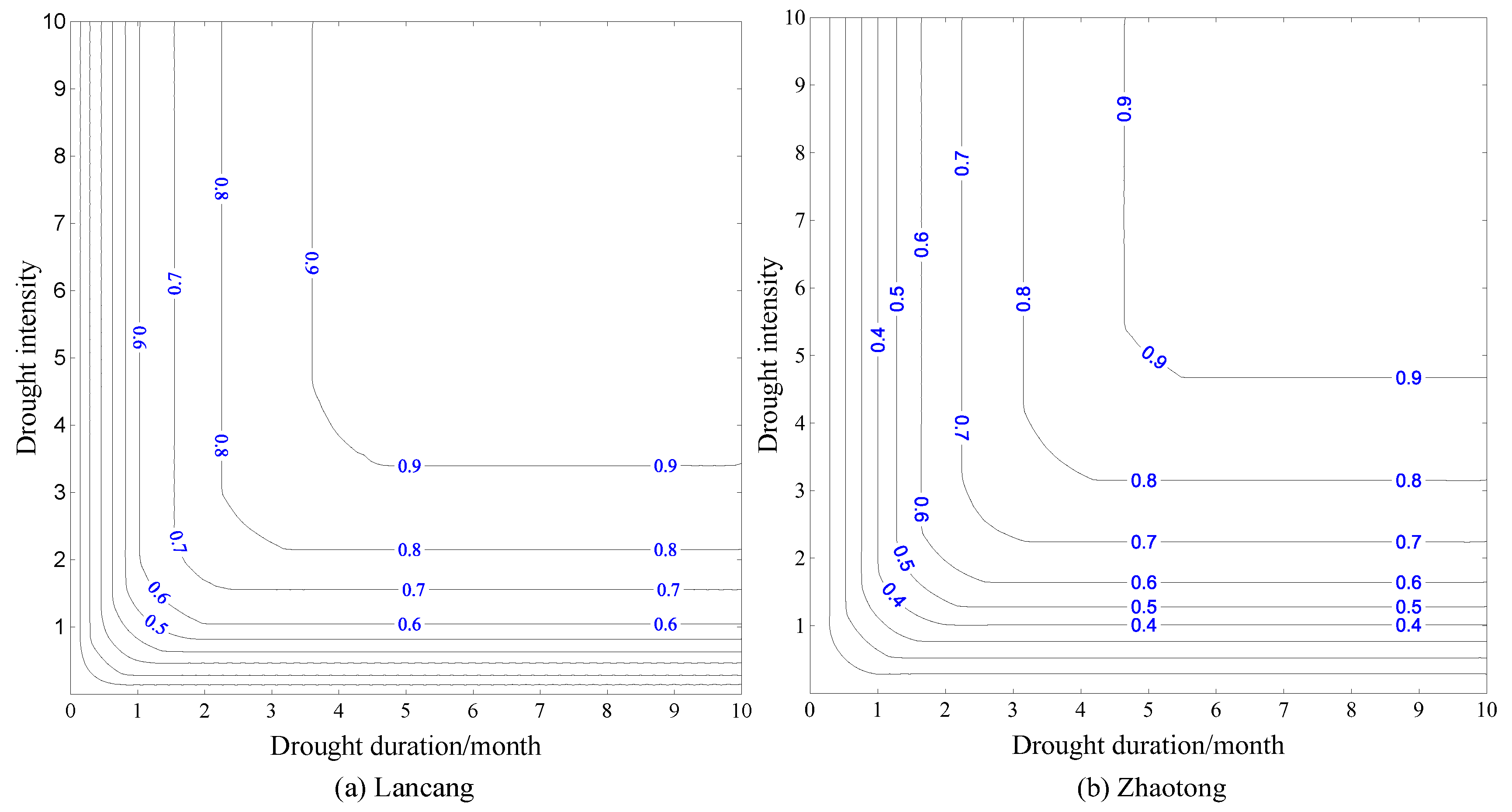
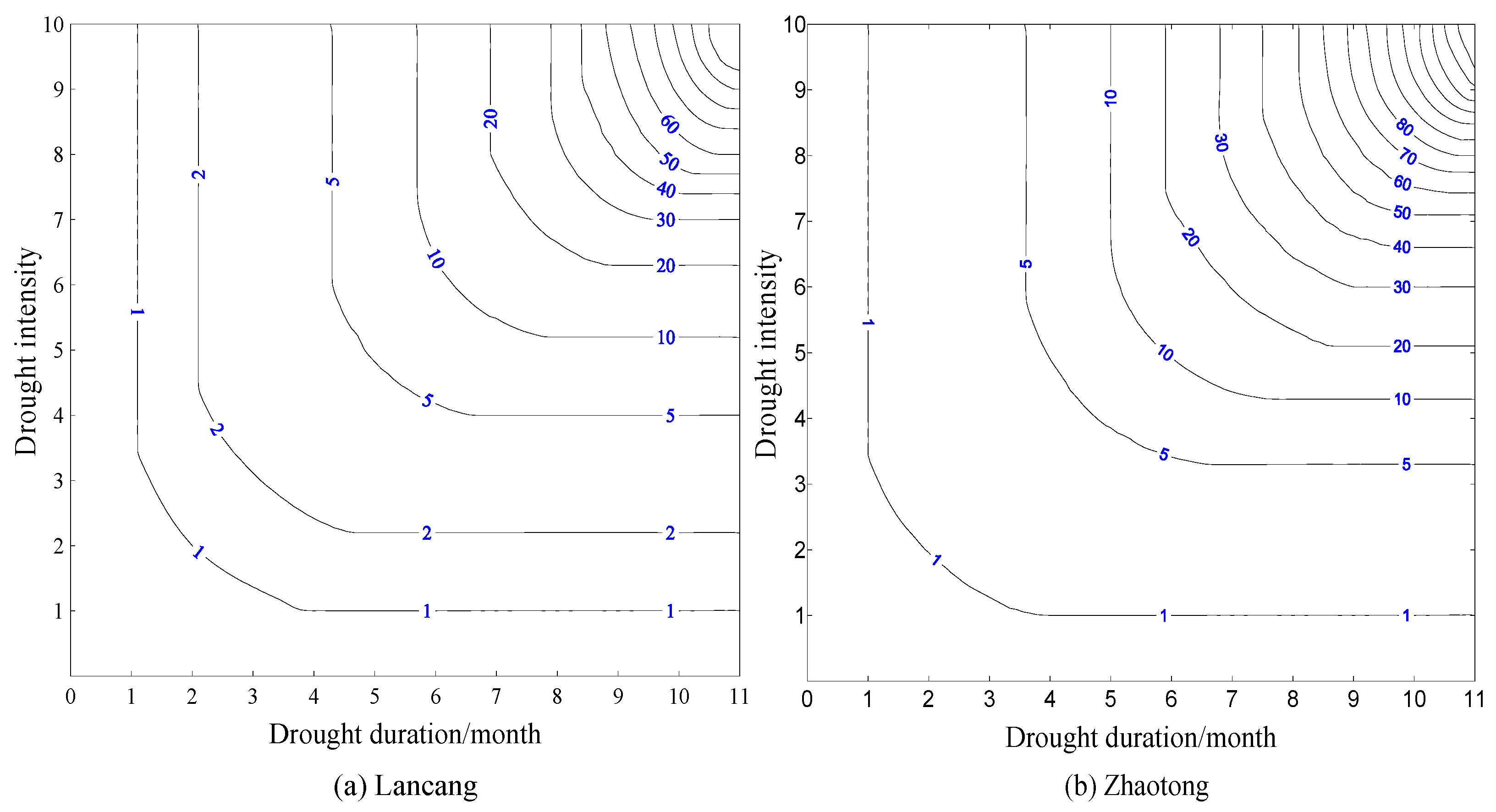
| Region. | Winter | Spring | Summer | Autumn |
|---|---|---|---|---|
| Northwest Yunnan | SPI | SPI | SPI | SPI |
| Southwest Yunnan | Pa | Pa | SPEI | SPEI |
| Central Yunnan | SPI/Pa | SPI/Pa | SPEI | SPEI |
| Northeast Yunnan | SPI | SPI | SPEI | SPEI |
| Southeast Yunnan | CInew | CInew | SPEI | SPEI |
| SPI | SPEI | Pa | CInew | Drought Category |
|---|---|---|---|---|
| −0.5 < SPI | −0.5 < SPEI | −0.4 < Pa | −0.6 < CInew | No drought |
| −1.0 < SPI ≤ −0.5 | −1.0 < SPEI ≤ −0.5 | −0.6 < Pa ≤ −0.4 | −1.2 < CInew ≤ −0.6 | Slight drought |
| −1.5 < SPI ≤ −1.0 | −1.5 < SPEI ≤ −1.0 | −0.8 < Pa ≤ −0.6 | −1.8 < CInew ≤ −1.2 | Moderate drought |
| −2.0 < SPI ≤ −1.5 | −2.0 < SPEI ≤ −1.5 | −0.95 < Pa ≤ −0.8 | −2.4 < CInew ≤ −1.8 | Severe drought |
| SPI ≤ −2.0 | SPEI ≤ −2.0 | Pa ≤ −0.95 | CInew ≤ −2.4 | Extreme drought |
| Copula Type | Copula Formula | Relationship between and |
|---|---|---|
| Gumbel–Hougaard | ||
| Ali–Mikhail–Haq | ||
| Frank | ||
| Clayton |
| Drought Index | Rainy Season (May-September) | Non-Rainy Season (October-April) | ||||
|---|---|---|---|---|---|---|
| R0 | R1 | R2 | R0 | R1 | R2 | |
| SPI | 0 | −0.5 | −1.0 | 0 | −0.5 | −1.0 |
| SPEI | 0 | −0.5 | −1.0 | 0 | −0.5 | −1.0 |
| Pa | 0 | −0.4 | −0.6 | 0.2 | −0.4 | −0.6 |
| CInew | 0 | −0.6 | −1.2 | 0.2 | −0.6 | −1.2 |
| Station Number | Station | Gumbel–Hougaard | Ali–Mikhail–Haq | Frank | Clayton | ||||
|---|---|---|---|---|---|---|---|---|---|
| RMSE | AIC | RMSE | AIC | RMSE | AIC | RMSE | AIC | ||
| 1 | Zhaotong | 0.0553 | −356.98 | 0.1132 | −268.15 | 0.0414 * | −392.87 * | 0.0461 | −379.54 |
| 2 | Huize | 0.0564 | −302.78 | 0.1255 | −218.00 | 0.0322 * | −362.19 * | 0.0528 | −309.77 |
| 3 | Zhanyi | 0.0678 | −310.18 | 0.0994 | −265.80 | 0.0461 * | −354.93 * | 0.0652 | −314.71 |
| 4 | Luxi | 0.0673 | −213.89 | 0.1046 | −178.61 | 0.0485 | −240.10 | 0.0388 * | −257.95 * |
| 5 | Guangnan | 0.0467 | −304.40 | 0.1284 | −203.26 | 0.0374 * | −326.61 * | 0.0402 | −319.39 |
| 6 | Pingbian | 0.0598 | −437.41 | 0.1325 | −313.30 | 0.0527 * | −457.13 * | 0.0566 | −445.99 |
| 7 | Mengzi | 0.0632 | −274.15 | 0.1068 | −221.68 | 0.0498 * | −297.97 * | 0.0549 | −288.22 |
| 8 | Deqing | 0.0595 | −235.03 | 0.0984 | −192.77 | 0.0459 * | −256.83 * | 0.0482 | −252.72 |
| 9 | Gongshan | 0.0641 | −437.57 | 0.1302 | −324.19 | 0.0546 * | −463.24 * | 0.0674 | −429.54 |
| 10 | Weixi | 0.0214 * | −267.11 * | 0.0867 | −169.17 | 0.0392 | −224.74 | 0.0413 | −221.08 |
| 11 | Zhongdian | 0.0269 * | −301.71 * | 0.1162 | −178.81 | 0.0447 | −259.05 | 0.0658 | −226.58 |
| 12 | Lijiang | 0.0562 | −320.43 | 0.1008 | −255.00 | 0.0432 * | −349.89 * | 0.0443 | −347.08 |
| 13 | Dali | 0.0438 | −335.84 | 0.0925 | −255.10 | 0.0361 * | −356.72 * | 0.0475 | −327.08 |
| 14 | Huaping | 0.0602 | −279.01 | 0.1226 | −207.88 | 0.0335 * | −337.62 * | 0.0458 | −306.35 |
| 15 | Baoshan | 0.0534 | −261.70 | 0.1347 | −178.42 | 0.0387 | −290.67 | 0.0209 * | −346.12 * |
| 16 | Tengchong | 0.0722 | −444.81 | 0.1389 | −333.58 | 0.0545 * | −492.62 * | 0.0657 | −460.85 |
| 17 | Ruili | 0.0599 | −335.81 | 0.1231 | −249.37 | 0.0429 * | −375.87 * | 0.0463 | −366.71 |
| 18 | Lincang | 0.0569 | −313.31 | 0.1334 | −219.58 | 0.0343 * | −368.99 * | 0.0422 | −346.19 |
| 19 | Lancang | 0.0435 | −399.28 | 0.1273 | −261.83 | 0.0297 * | −448.13 * | 0.0348 | −427.84 |
| 20 | Jingdong | 0.0545 | −288.96 | 0.1089 | −219.73 | 0.0388 | −322.93 | 0.0306 * | −346.68 * |
| 21 | Simao | 0.0474 | −382.19 | 0.1332 | −252.00 | 0.0354 * | −418.97 * | 0.0440 | −391.57 |
| 22 | Jinghong | 0.0687 | −260.44 | 0.0347* | −327.38 * | 0.0402 | −312.96 | 0.0459 | −299.97 |
| 23 | Mengla | 0.0546 | −381.82 | 0.1077 | −292.15 | 0.0467 * | −402.45 * | 0.0485 | −397.46 |
| 24 | Jiangcheng | 0.0695 | −451.29 | 0.1115 | −370.93 | 0.0532 * | −496.73 * | 0.0646 | −463.72 |
| 25 | Yuanjiang | 0.0663 | −339.91 | 0.1369 | −248.55 | 0.0449 * | −389.02 * | 0.0487 | −378.78 |
| 26 | Yuanmou | 0.0416 | −360.48 | 0.1032 | −256.90 | 0.0298 * | −398.51 * | 0.0371 | −373.53 |
| 27 | Kunming | 0.0628 | −330.14 | 0.1141 | −258.48 | 0.0379 * | −390.74 * | 0.0449 | −370.40 |
| 28 | Chuxiong | 0.0582 | −327.89 | 0.1273 | −237.10 | 0.0485 * | −349.04 * | 0.0555 | −333.40 |
| 29 | Yuxi | 0.0605 | −300.95 | 0.1204 | −226.63 | 0.0392 * | −347.82 * | 0.0424 | −339.35 |
| Year | Drought Duration | Return Period (Years) | Drought Grade | Crop Production Area (Million hm2) | ||
|---|---|---|---|---|---|---|
| Actual | Theoretical | Actual | Theoretical | |||
| 1991 | 03−06 | 03−06 | 1.5 | 1.7 | Slight drought | 1.2 |
| 1992 | 06−11 | 06−10 | 6.7 | 6.6 | Moderate drought | 4.6 |
| 1993 | 06−12 | 06−12 | 10.8 | 10.5 | Severe drought | 10.2 |
| 1994 | 04−06 | 04−07 | 2.6 | 2.6 | Slight drought | 2.5 |
| 1995 | 02−04 | 02−05 | 1.5 | 1.2 | Slight drought | 2.4 |
| 1996 | 03−05 | 03−06 | 1.0 | 0.9 | Slight drought | 3.6 |
| 1997 | 03−05 | 03−05 | 0.9 | 0.8 | Slight drought | 3.9 |
| 1998 | 02−07 | 03−07 | 4.2 | 4.3 | Moderate drought | 6.7 |
| 1999 | 02−05 | 02−06 | 2.6 | 2.2 | Slight drought | 4.2 |
| 2000 | 08−11 | 08−10 | 1.8 | 1.6 | Slight drought | 3.9 |
| 2001 | 03−08 | 03−08 | 5.0 | 5.3 | Moderate drought | 7.6 |
| 2002 | 04−10 | 04−10 | 9.6 | 9.8 | Moderate drought | 8.1 |
| 2003 | 01−10 | 02−10 | 19.5 | 19.3 | Severe drought | 12.4 |
| 2004 | 08−11 | 08−11 | 4.4 | 4.2 | Moderate drought | 7.8 |
| 2005 | 03−09 | 03−09 | 13.8 | 13.4 | Severe drought | 11.3 |
| 2006 | 02−08 | 02−09 | 12.0 | 11.7 | Severe drought | 13.9 |
| 2007 | 02−05 | 02−06 | 2.1 | 2.2 | Slight drought | 4.1 |
| 2008 | 03−08 | 04−08 | 4.3 | 4.5 | Moderate drought | 8.5 |
| 2009 | 06−12 | 06−12 | 9.8 | 9.8 | Moderate drought | 8.5 |
| 2010 | 01−09 | 02−09 | 25.5 | 25.5 | Extreme drought | 16.5 |
| 2011 | 03−12 | 02−12 | 108.2 | 108.5 | Extreme drought | 28.8 |
| 2012 | 03−10 | 03−10 | 22.3 | 22.7 | Extreme drought | 17.3 |
| 2013 | 02−08 | 02−09 | 17.8 | 17.5 | Severe drought | 12.6 |
| 2014 | 04−07 | 03−07 | 4.5 | 4.3 | Moderate drought | 6.6 |
| 2015 | 05−08 | 04−08 | 3.9 | 3.8 | Moderate drought | 5.9 |
| Year | Drought Duration | Return Period (Years) | Drought Grade | Crop Production Area (Million hm2) | ||
|---|---|---|---|---|---|---|
| Actual | Theoretical | Actual | Theoretical | |||
| 1991 | 03−03 | 03−04 | 0.8 | 0.8 | Slight drought | 0.13 |
| 1992 | 05−08 | 05−09 | 3.5 | 3.6 | Moderate drought | 0.45 |
| 1993 | 07−09 | 07−09 | 2.5 | 2.7 | Slight drought | 0.22 |
| 1994 | 04−04 | 04−04 | 0.7 | 0.9 | Slight drought | 0.18 |
| 1995 | 03−04 | 03−04 | 1.2 | 1.5 | Slight drought | 0.25 |
| 1996 | 03−03 | 03−04 | 0.5 | 0.5 | Slight drought | 0.12 |
| 1997 | 05−06 | 05−06 | 1.0 | 0.8 | Slight drought | 0.23 |
| 1998 | 03−05 | 03−06 | 4.0 | 4.2 | Moderate drought | 0.65 |
| 1999 | 02−03 | 02−02 | 1.8 | 1.8 | Slight drought | 0.29 |
| 2000 | 04−04 | 03−04 | 0.7 | 0.7 | Slight drought | 0.14 |
| 2001 | 03−05 | 03−06 | 1.6 | 1.5 | Slight drought | 0.20 |
| 2002 | 03−05 | 03−05 | 1.3 | 1.4 | Slight drought | 0.21 |
| 2003 | 04−06 | 04−06 | 2.0 | 1.7 | Slight drought | 0.27 |
| 2004 | 03−04 | 03−04 | 1.3 | 1.3 | Slight drought | 0.19 |
| 2005 | 04−06 | 04−07 | 2.5 | 2.7 | Slight drought | 0.33 |
| 2006 | 06−07 | 06−08 | 0.9 | 0.9 | Slight drought | 0.18 |
| 2007 | 06−06 | 06−07 | 0.8 | 0.8 | Slight drought | 0.18 |
| 2008 | 05−07 | 05−07 | 1.6 | 1.4 | Slight drought | 0.37 |
| 2009 | 07−12 | 07−11 | 7.6 | 7.5 | Severe drought | 0.98 |
| 2010 | 01−08 | 01−09 | 31 | 31.4 | Extreme drought | 1.88 |
| 2011 | 04−09 | 05−09 | 10.2 | 10.2 | Severe drought | 1.34 |
| 2012 | 01−04 | 01−05 | 3.4 | 3.2 | Moderate drought | 0.51 |
| 2013 | 03−06 | 02−06 | 3.5 | 3.6 | Moderate drought | 0.56 |
| 2014 | 05−08 | 05−09 | 1.9 | 1.9 | Slight drought | 0.29 |
| 2015 | 06−08 | 06−08 | 1.3 | 1.2 | Slight drought | 0.22 |
© 2020 by the authors. Licensee MDPI, Basel, Switzerland. This article is an open access article distributed under the terms and conditions of the Creative Commons Attribution (CC BY) license (http://creativecommons.org/licenses/by/4.0/).
Share and Cite
Wang, L.; Zhang, X.; Wang, S.; Salahou, M.K.; Fang, Y. Analysis and Application of Drought Characteristics Based on Theory of Runs and Copulas in Yunnan, Southwest China. Int. J. Environ. Res. Public Health 2020, 17, 4654. https://doi.org/10.3390/ijerph17134654
Wang L, Zhang X, Wang S, Salahou MK, Fang Y. Analysis and Application of Drought Characteristics Based on Theory of Runs and Copulas in Yunnan, Southwest China. International Journal of Environmental Research and Public Health. 2020; 17(13):4654. https://doi.org/10.3390/ijerph17134654
Chicago/Turabian StyleWang, Liping, Xingnan Zhang, Shufang Wang, Mohamed Khaled Salahou, and Yuanhao Fang. 2020. "Analysis and Application of Drought Characteristics Based on Theory of Runs and Copulas in Yunnan, Southwest China" International Journal of Environmental Research and Public Health 17, no. 13: 4654. https://doi.org/10.3390/ijerph17134654
APA StyleWang, L., Zhang, X., Wang, S., Salahou, M. K., & Fang, Y. (2020). Analysis and Application of Drought Characteristics Based on Theory of Runs and Copulas in Yunnan, Southwest China. International Journal of Environmental Research and Public Health, 17(13), 4654. https://doi.org/10.3390/ijerph17134654





